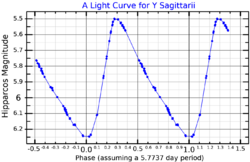Astronomy:Y Sagittarii
| Observation data Equinox J2000.0]] (ICRS) | |
|---|---|
| Constellation | Sagittarius |
| Right ascension | 18h 21m 22.98643s[2] |
| Declination | −18° 51′ 36.0018″[2] |
| Apparent magnitude (V) | 5.76[3] |
| Characteristics | |
| Spectral type | F8 II[4] |
| B−V color index | 0.67±0.02[3] |
| Variable type | Cepheid variable[4] |
| Astrometry | |
| Radial velocity (Rv) | −1.4±2.3[3] km/s |
| Proper motion (μ) | RA: −3.12[2] mas/yr Dec.: −7.12[2] mas/yr |
| Parallax (π) | 2.13 ± 0.29[5] mas |
| Distance | approx. 1,500 ly (approx. 470 pc) |
| Absolute magnitude (MV) | −2.06[3] |
| Details | |
| Surface gravity (log g) | 1.80[4] cgs |
| Temperature | 5,967±26[4] K |
| Age | 330[6] Myr |
| Other designations | |
| Database references | |
| SIMBAD | data |
Y Sagittarii is a variable star in the constellation of Sagittarius. It is a Cepheid variable with an apparent magnitude that ranges around +5.77. The measure of its parallax by Hubble Space Telescope puts Y Sagittarii to 1,293 light-years away from the Solar System.
The brightness ranges in Y Sagittarii's apparent magnitude varies from +5.25 and +6.24 in a period of 5.7736 days. The spectral type of this star is F8II, while the effective temperature is 5370 K. It has a radius 50 times larger than the Sun, while its projected rotational velocity of 16 km / s and it has an estimated mass six times that of the Sun. The star's metal content is similar to Sun, with an index of metallicity [Fe / H] = +0.05. For other metals tested, it shows some overabundance of copper, zinc, yttrium and sodium; the level of the elements is almost double that of the Sun ([Na / H] = +0.27).[8]
There is evidence that Y Sagittarii may be a spectroscopic binary. It has been suggested that the orbital period for the system is on the order of 10,000 to 12,000 days. However, subsequent studies assume eccentricity zero for orbit, and they have failed to find a convincing orbital solution. Instead, it appears to be a distant visual companion.[9]
References
- ↑ "Light Curve". ESA. https://www.cosmos.esa.int/web/hipparcos/java-tools/light-curve.
- ↑ 2.0 2.1 2.2 2.3 van Leeuwen, F. (2007), "Validation of the new Hipparcos reduction", Astronomy and Astrophysics 474 (2): 653–664, doi:10.1051/0004-6361:20078357, Bibcode: 2007A&A...474..653V.
- ↑ 3.0 3.1 3.2 3.3 Anderson, E.; Francis, Ch. (2012), "XHIP: An extended hipparcos compilation", Astronomy Letters 38 (5): 331, doi:10.1134/S1063773712050015, Bibcode: 2012AstL...38..331A.
- ↑ 4.0 4.1 4.2 4.3 Usenko, I. A. et al. (July 2013), "Spectroscopic studies of southern-hemisphere Cepheids: Six objects in Centaurus (V Cen, V737 Cen) and Sagittarius (BB Sgr, W Sgr, X Sgr, Y Sgr)", Astronomy Letters 39 (7): 432–445, doi:10.1134/S1063773713070074, Bibcode: 2013AstL...39..432U.
- ↑ Benedict, G. Fritz et al. (January 2017), "Astrometry with Hubble Space Telescope Fine Guidance Sensors—A Review", Publications of the Astronomical Society of the Pacific 129 (971): 012001, doi:10.1088/1538-3873/129/971/012001, Bibcode: 2017PASP..129a2001B.
- ↑ "HIP 89968", Wolfram Alpha, http://www.wolframalpha.com/input/?i=HIP+89968, retrieved 2012-09-17.
- ↑ "V* Y Sgr". SIMBAD. Centre de données astronomiques de Strasbourg. http://simbad.u-strasbg.fr/simbad/sim-basic?Ident=V%2A+Y+Sgr.
- ↑ J., Duncan (August 2013), "Changes in the spectrographic elements of Y Sagittarii", Astrophysical Journal 56: 340–341, doi:10.1086/142708, Bibcode: 1922ApJ....56..340D.
- ↑ Evans, Nancy Remage et al. (December 2020), "Hubble Space Telescope Snapshot Survey for Resolved Companions of Galactic Cepheids: Final Results", The Astrophysical Journal 905 (1): 34, doi:10.3847/1538-4357/abc1f1, 81, Bibcode: 2020ApJ...905...81E.
 |


